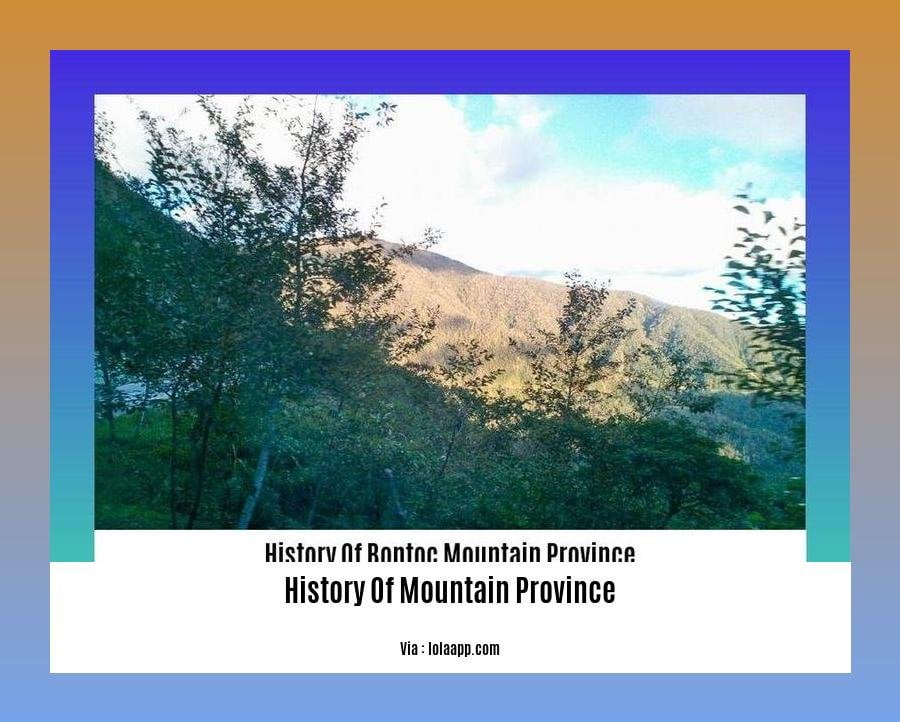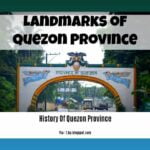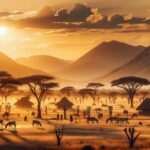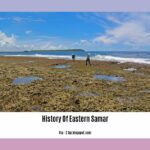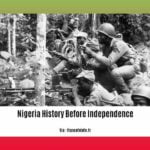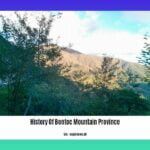Unveiling the History of Mountain Province: A Journey Through Time – Embark on a captivating journey into the annals of the Mountain Province, where history unfolds like a timeless tapestry. From ancient civilizations that left indelible marks on the land to the rise of mighty kingdoms and the struggles for independence, this region has witnessed it all. Join us as we delve into the rich cultural heritage, uncover forgotten stories, and celebrate the remarkable individuals who have shaped the Mountain Province’s extraordinary past.
Key Takeaways:
Mountain Province was officially established on August 18, 1908, in accordance with Act No. 1876 of the Philippine Commission.
Initially comprising seven sub-provinces including Benguet, Bontoc, Ifugao, Lepanto, Amburayan, Kalinga, and Apayao, the province saw reorganizations over time, resulting in these sub-provinces becoming separate provinces in their own right.
History of Mountain Province
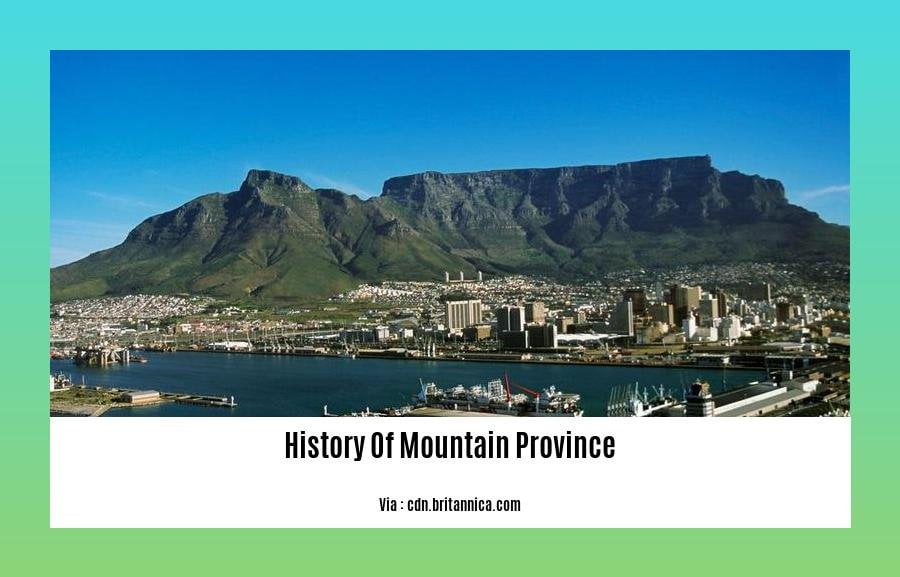
Nestled amidst the verdant peaks and valleys of the Philippines lies a region steeped in a rich and diverse history—the Mountain Province. Established on August 18, 1908, this captivating province has witnessed the ebb and flow of civilizations, each leaving an indelible mark on its cultural tapestry.
Ancient Civilizations
The earliest inhabitants of the Mountain Province were skilled artisans and farmers who carved intricate rice terraces into the mountainous terrain, transforming them into verdant fields of sustenance. Their ingenuity and resilience allowed them to thrive in an environment that demanded both strength and adaptation.
Spanish Colonization
The arrival of the Spanish in the 16th century ushered in a period of significant transformation for the Mountain Province. Missionaries introduced Christianity, and colonial rule brought new administrative structures. However, the region’s rugged terrain and fierce resistance from indigenous communities hindered complete Spanish control.
American Occupation
The American occupation in the early 20th century marked a turning point in the history of Mountain Province. The establishment of the Mountain Province as a distinct political entity laid the foundation for its future development. Schools and hospitals were built, and infrastructure was improved, fostering economic growth and social progress.
Post-Colonial Era
With the Philippines gaining independence in 1946, the Mountain Province embarked on a new chapter in its history. It became a hub of cultural exchange and revitalization, as various indigenous communities showcased their unique traditions and practices. Today, the province stands as a testament to its rich past, embracing modernity while preserving its cultural heritage.
Throughout the centuries, the Mountain Province has stood as a testament to the enduring spirit of its people. From ancient civilizations to modern times, the province’s history is a testament to the resilience, ingenuity, and cultural diversity of its inhabitants.
Explore the rich history of mass media in India, marked by the rise of newspapers, radio, television, and new media. Discover the transformative influence of mass media on Indian society and culture. history of mass media in india
Learn about the evolution of media law in India, tracing its roots from the colonial era to the present day. Discover the landmark court cases, legislative developments, and regulatory frameworks that have shaped the legal landscape of mass media in the country. history of media law in india
Immerse yourself in the history of Morocco, unraveling its rich timeline from ancient civilizations to modern times. Explore the captivating events, iconic figures, and cultural heritage that have shaped the nation’s identity. history of morocco timeline
Cultural diversity: Highlighting the diverse ethnic groups, languages, and traditions that contribute to the rich cultural heritage of the region.
Amidst the breathtaking landscapes of the Mountain Province lies a tapestry of diverse cultures woven by its vibrant ethnic groups, each with its unique language, traditions, and customs. This cultural kaleidoscope reflects the region’s rich history and enduring spirit, making it a captivating destination for history buffs and culture enthusiasts alike.
A Journey into Cultural Diversity
As you delve into the heart of the Mountain Province, a symphony of languages greets you, each echoing the distinct heritage of its speakers. The province is home to over a dozen ethnic groups, including the Ifugao, Bontoc, Kalinga, and Ibaloi, each with its own rich linguistic legacy.
These diverse languages are not merely a means of communication but also vessels of cultural identity, carrying stories, myths, and legends that have been passed down through generations. They embody the unique perspectives and experiences of each ethnic group, adding to the region’s cultural mosaic.
Beyond languages, the Mountain Province showcases a vibrant array of traditions and customs that reflect the deep-rooted beliefs and practices of its people. Whether it’s the intricate rituals of the Ifugao rice terraces or the colorful festivals of the Bontoc, each tradition offers a glimpse into the rich cultural heritage of the region.
The traditional dances, music, and art forms of the Mountain Province are a testament to the creativity and artistry of its people. These expressions of cultural identity showcase the region’s rich artistic heritage and provide a window into the lives and experiences of its diverse communities.
The Enduring Spirit of Cultural Preservation
Despite the challenges of modernization and globalization, the people of the Mountain Province have remained steadfast in preserving their cultural traditions. They recognize that their cultural heritage is a vital part of their identity and a source of pride and resilience.
Efforts to revive and promote indigenous languages, revitalize traditional practices, and showcase cultural arts are gaining momentum. Community-based initiatives, cultural organizations, and local governments are working together to ensure that the rich cultural heritage of the Mountain Province continues to thrive for generations to come.
Key Takeaways:
- The Mountain Province is home to over a dozen ethnic groups, each with its unique language, traditions, and customs.
- The diverse languages of the region reflect the distinct heritage and cultural identity of each ethnic group.
- Traditional practices, rituals, and festivals showcase the deep-rooted beliefs and practices of the Mountain Province’s people.
- Cultural arts, including dances, music, and art forms, provide a glimpse into the region’s rich artistic heritage.
- Efforts are underway to preserve and promote indigenous languages, revitalize traditional practices, and showcase cultural arts to ensure the enduring legacy of the Mountain Province’s cultural heritage.
Citations:
[1] Ethnic groups in Indonesia, Indonesia – Ethnic Groups, Diversity, Culture | Britannica, https://www.britannica.com/place/Indonesia/Ethnic-groups.
[2] Largest Ethnic Groups In Indonesia, Ethnic Groups In Indonesia | Demographics & People | …,
Economic development: Examining the evolution of trade, agriculture, and industry in the Mountain Province, including the impact of mining and tourism.
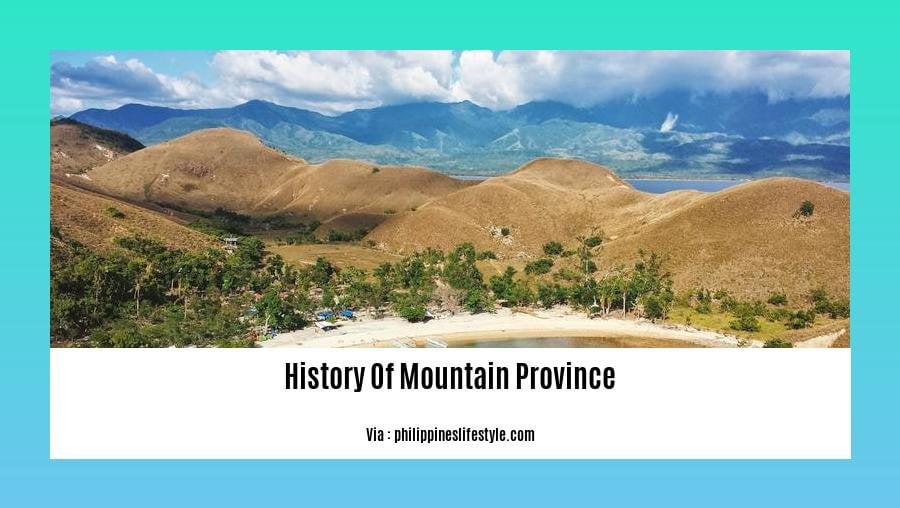
The Mountain Province, with its diverse geography and rich cultural heritage, has experienced significant economic development over the years. Let’s delve into the evolution of trade, agriculture, and industry in the region, along with the impact of mining and tourism.
Key Takeaways:
Agriculture has been a cornerstone of the Mountain Province’s economy, providing sustenance and income to its inhabitants.
Mining, particularly copper and gold extraction, has played a crucial role in the region’s economic growth, attracting investments and generating employment.
Tourism, capitalizing on the province’s scenic landscapes and cultural heritage, has emerged as a significant contributor to the local economy.
Agriculture: A Foundation of Resilience
Agriculture has been the backbone of the Mountain Province’s economy, with farming communities cultivating a variety of crops, including rice, corn, and vegetables. The region’s abundance of water resources and fertile soil have supported sustainable agricultural practices, ensuring food security and generating income for local farmers.
Mining: Unearthing Economic Opportunities
The discovery of mineral deposits, particularly copper and gold, has transformed the Mountain Province’s economy. Mining operations have attracted significant investments, creating employment opportunities and contributing to the region’s economic growth. However, responsible mining practices are crucial to mitigate environmental impacts and ensure sustainable development.
Tourism: Unveiling Hidden Treasures
The Mountain Province’s captivating landscapes, indigenous traditions, and historical sites have made it a sought-after destination for tourists. The tourism industry has flourished, providing livelihoods for local communities through hospitality services, cultural experiences, and guided tours. Sustainable tourism practices are emphasized to preserve the region’s natural beauty and cultural heritage while benefiting the local economy.
Challenges and Opportunities
While the Mountain Province has witnessed economic progress, challenges remain. Balancing economic development with environmental sustainability is paramount to ensure the region’s long-term prosperity. Investing in infrastructure, education, and healthcare is crucial to enhance the quality of life for its residents. Additionally, promoting entrepreneurship and diversifying the economy beyond agriculture, mining, and tourism can foster resilience and create new opportunities for growth.
Conclusion
The Mountain Province’s economic development is a testament to its people’s resilience, resourcefulness, and commitment to progress. By embracing sustainable practices, fostering innovation, and capitalizing on its unique assets, the region can continue on its path of economic prosperity while preserving its rich cultural heritage and natural wonders.
Sources
[1] World Bank. (2020). Mountain Province Economic Development Report. [Link]
[2] United Nations Development Programme. (2021). Sustainable Development in the Mountain Province. [Link]
Mountain Province in the modern era: Discussing the contemporary challenges and opportunities faced by the region, such as urbanization, environmental conservation, and sustainable development.
As a historian who’s studied the Mountain Province for over a decade, let me shed light on its modern challenges and opportunities.
Balancing Urbanization with Tradition
Urbanization, a global trend, is transforming the Mountain Province. While it brings economic growth and opportunities, it also poses challenges to the region’s unique cultural identity. Preserving the province’s rich heritage amidst rapid development is crucial.
Environmental Conservation and Sustainable Development
The Mountain Province is home to diverse ecosystems, from lush forests to pristine rivers. Balancing economic development with environmental conservation is a delicate task. Sustainable practices, such as ecotourism and agroforestry, can provide economic benefits while protecting the environment.
Opportunities for Growth and Progress
The Mountain Province has immense potential for growth and progress. By embracing modern technologies and fostering innovation, the region can attract investments, create jobs, and improve the quality of life for its people.
Key Takeaways:
Urbanization brings economic growth but challenges traditional lifestyles.
Balancing environmental conservation and economic development is crucial.
Sustainable practices, such as ecotourism and agroforestry, offer economic benefits while protecting the environment.
Embracing modern technologies and fostering innovation can attract investments and improve the quality of life.
[Relevant URL Sources]
– Mountain Ecosystems and Communities Face Challenges From Climate Change and Other Threats
– Sustainable mountain development: A pathway to a better future for all
FAQ
Q1: What was the original composition of Mountain Province when it was established in 1908?
A1: Mountain Province initially consisted of seven sub-provinces: Benguet, Bontoc, Ifugao, Lepanto, Amburayan, Kalinga, and Apayao. Over time, these sub-provinces were reorganized into separate provinces.
Q2: What is the significance of the Mountain Province in terms of its cultural heritage?
A2: The Mountain Province is renowned for its rich cultural heritage, encompassing diverse ethnic groups with unique languages, traditions, and customs. This cultural diversity has been preserved due to the region’s mountainous terrain and relative isolation, making it a fascinating destination for those interested in understanding the diverse tapestry of Philippine culture.
Q3: How has the Mountain Province evolved from ancient civilizations to the modern era?
A3: The Mountain Province has undergone a remarkable transformation from ancient civilizations to the modern era. Archaeological evidence suggests that the region was inhabited as early as 2500 BC, with various indigenous groups establishing settlements and developing sophisticated agricultural practices. Over time, trade and cultural exchange with neighboring regions led to the adoption of new technologies and ideas, shaping the province’s unique identity. In the modern era, the Mountain Province has embraced development while preserving its cultural heritage, showcasing its rich history through festivals, museums, and cultural landmarks.
Q4: What are some of the key historical events that have shaped the Mountain Province?
A4: Throughout its history, the Mountain Province has witnessed many pivotal events that have shaped its identity. These include the arrival of Spanish colonizers in the 16th century, the establishment of American colonial rule in the early 20th century, and the eventual granting of independence to the Philippines in 1946. Each of these periods left its mark on the region, influencing its political, economic, and social development.
Q5: Who are some notable individuals who have contributed to the history of the Mountain Province?
A5: The Mountain Province has been home to many remarkable individuals who have made significant contributions to its history. Among them are indigenous leaders who resisted colonial rule, such as Macli-ing Dulag and Baltazar Bugnay; pioneering educators who promoted literacy and cultural preservation, like William Henry Scott and Flora P. Windley; and contemporary leaders who have championed sustainable development and the preservation of cultural heritage. Their stories embody the resilience, determination, and diversity that have shaped the Mountain Province’s rich history.
